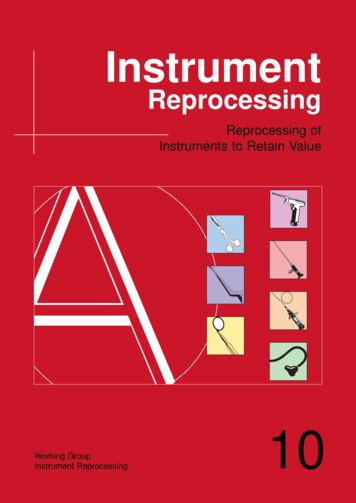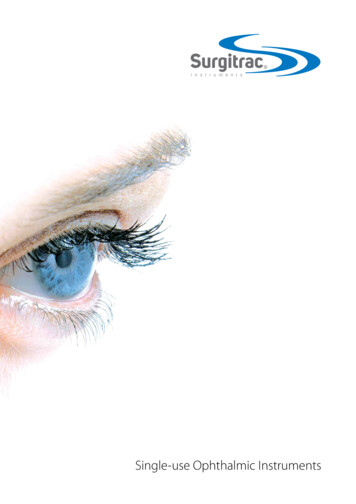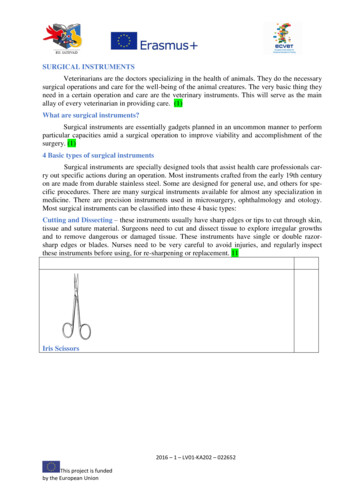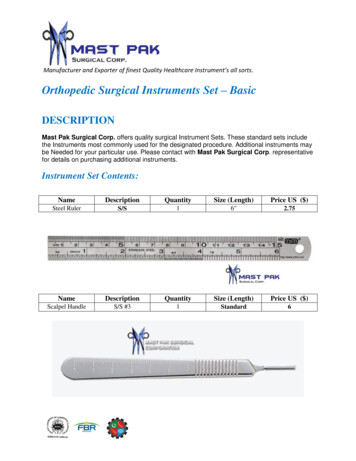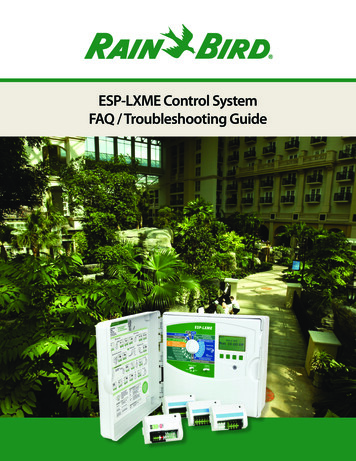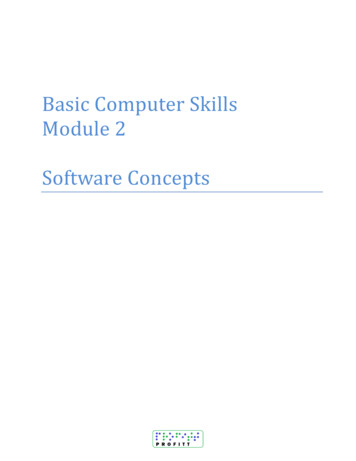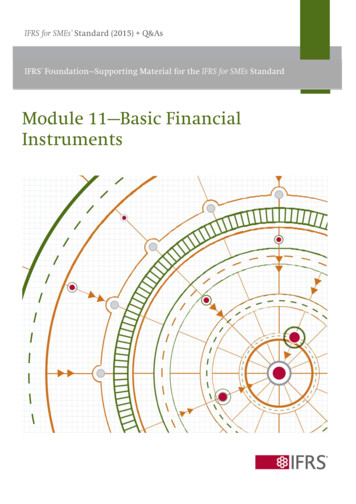
Transcription
IFRS for SMEs Standard (2015) Q&AsIFRS Foundation—Supporting Material for the IFRS for SMEs StandardModule 11—Basic FinancialInstrumentsSupporting Material for the IFRS for SMEs Stand
IFRS FoundationSupporting Materialfor the IFRS for SMEs Standardincluding the full text ofSection 11 Basic Financial Instrumentsof the IFRS for SMEs Standardissued by the International Accounting Standards Board in October 2015with extensive explanations, self-assessment questions and case studiesIFRS FoundationColumbus Building7 Westferry CircusCanary WharfLondon E14 4HDUnited KingdomTelephone: 44 (0)20 7246 6410Email: info@ifrs.orgWeb: www.ifrs.orgPublications DepartmentTelephone: 44 (0)20 7332 2730Email: publications@ifrs.org
This module has been prepared by IFRS Foundation (Foundation) education staff. It has not been approved by the International AccountingStandards Board (Board). The module is designed to assist users of the IFRS for SMEs Standard (Standard) to implement and consistentlyapply the Standard.All rights, including copyright, in the content of this publication are owned by the IFRS Foundation.Copyright 2018 IFRS Foundation. All rights reserved.Email: info@ifrs.org Web: www.ifrs.orgDisclaimer: All implied warranties, including but not limited to the implied warranties of satisfactory quality, fitness for a particularpurpose, non-infringement and accuracy, are excluded to the extent that they may be excluded as a matter of law. To the extentpermitted by applicable law, the Board and the Foundation expressly disclaim all liability howsoever arising whether in contract, tort orotherwise (including, but not limited to, liability for any negligent act or omissions) to any person in respect of any claims or losses of anynature, arising directly or indirectly from: (i) anything done or the consequences of anything done or omitted to be done wholly or partlyin reliance upon the whole or any part of the contents of this publication; and (ii) the use of any data or materials contained in thispublication or otherwise. To the extent permitted by applicable law, the Board, the Foundation, the authors and the publishers shall notbe liable for any loss or damage of any kind arising from use of and/or reliance on the contents of this publication or any translationthereof, including but not limited to direct, indirect, incidental or consequential loss, punitive damages, penalties or costs.Information contained in this publication does not constitute advice and should not be used as a basis for making decisions or treated asa substitute for specific advice on a particular matter from a suitably qualified professional person. For relevant accountingrequirements, reference must be made to the Standard issued by the Board.Any names of individuals, companies and/or places used in this publication are fictitious and any resemblance to real people, entities orplaces is purely coincidental.Right of use: Although the Foundation encourages you to use this module for educational purposes, you must do so in accordance with theterms of use below. If you intend to include our material in a commercial product, please contact us as you will need a separate licence.For details on using our Standards, please visit www.ifrs.org/issued-standards.You must ensure you have the most current material available from our website. Your right to use this module will expire when this moduleis withdrawn or updated, at which time you must cease to use it and/or make it available. It is your sole responsibility to ensure you areusing relevant material by checking the Foundation’s website for any amendments to the Standard, SME Implementation Group Q&As notyet incorporated and/or new versions of the modules.Terms of Use1)You can only reproduce the module in whole or in part in a printed or electronic stand-alone document provided that:(a) such document is supplied to participants free of charge;(b) you do not use or reproduce, or allow anyone else to use or reproduce, the Foundation logo that appears on or in the module;(c) you do not use or reproduce any trade mark that appears on or in the module if you are using all or part of the material toincorporate into your own documentation; and(d) you can only provide this module in whole through your website if you include a prominent link to our website (please see ourterms and conditions page for details on how to link your website to ours).2)The trade marks include those listed below.3)When you copy any extract from this publication for inclusion in another document you must ensure:(a) the documentation includes a copyright acknowledgement;(b)the documentation includes a statement that the Foundation is the author of the module and that the original module can beaccessed via the IFRS website www.ifrs.org;(c)the documentation includes in a prominent place an appropriate disclaimer, like that shown above;(d)the extract is shown accurately; and(e)the extract is not used in a misleading context.If you intend to provide any part of this module in print or electronically for any other purpose, please contact the Foundation as you willneed a written licence which may or may not be granted. For more information, please contact the licences ng).Please address publication and copyright matters to IFRS Foundation Publications Department:Email: publications@ifrs.org Web: www.ifrs.orgTrade mark noticeThe IFRS Foundation has trade marks registered around the world, including ‘eIFRS ’, ‘International Accounting Standards ’, ‘IAS ’, ‘IASB ’,the IASB logo, ‘IFRIC ’, ‘International Financial Reporting Standards ’, ‘IFRS ’, the IFRS logo, ‘IFRS Foundation ’, ‘IFRS for SMEs ’, theIFRS for SMEs logo, the ‘Hexagon Device’, ‘NIIF ’ and ‘SIC ’. Further details of the IFRS Foundation’s trade marks are available from theIFRS Foundation on request.
ContentsINTRODUCTIONWhich version of the IFRS for SMEs Standard?This moduleIFRS for SMEs StandardIntroduction to the requirementsWhat has changed since the 2009 IFRS for SMEs Standard111235REQUIREMENTS AND EXAMPLES 6Scope of Sections 11 and 12 6Accounting policy choice 7Introduction to Section 11 8Scope of Section 11 15Basic financial instruments 17Initial recognition of financial assets and liabilities 30Initial measurement 31Subsequent measurement 42Derecognition of a financial asset 79Derecognition of a financial liability 87Disclosures 91SIGNIFICANT ESTIMATES AND OTHER JUDGEMENTS 99Initial measurement 99Subsequent measurement 100Derecognition 100COMPARISON WITH FULL IFRS STANDARDS 101TEST YOUR KNOWLEDGE 103APPLY YOUR KNOWLEDGECase study 1Answer to case study 1Case study 2Answer to case study 2IFRS Foundation: Supporting Material for the IFRS for SMEs Standard (version 2018-08)iv107107109112114
Module 11—Basic Financial InstrumentsThe accounting requirements applicable to small and medium-sized entities (SMEs)discussed in this module are set out in the IFRS for SMEs Standard, issued by theInternational Accounting Standards Board (Board) in October 2015.This module has been prepared by IFRS Foundation education staff.The contents of Section 11 Basic Financial Instruments of the IFRS for SMEs Standardare set out in this module and shaded grey. The Glossary of terms of the IFRS for SMEsStandard (Glossary) is also part of the requirements. Terms defined in the Glossary arereproduced in bold type the first time they appear in the text of Section 11. The notes andexamples inserted by the education staff are not shaded. These notes and examples donot form part of the IFRS for SMEs Standard and have not been approved by the Board.INTRODUCTIONWhich version of the IFRS for SMEs Standard?When the IFRS for SMEs Standard was first issued in July 2009, the Board said it wouldundertake an initial comprehensive review of the Standard to assess entities’ experience of thefirst two years of its application and to consider the need for any amendments. To this end, inJune 2012, the Board issued a Request for Information: Comprehensive Review of the IFRS for SMEs.An Exposure Draft proposing amendments to the IFRS for SMEs Standard was subsequentlypublished in 2013, and in May 2015 the Board issued 2015 Amendments to the IFRS for SMEsStandard.The document published in May 2015 only included amended text, but in October 2015, theBoard issued a fully revised edition of the Standard, which incorporated additional minoreditorial amendments as well as the substantive May 2015 revisions. This module is based onthat version.The IFRS for SMEs Standard issued in October 2015 is effective for annual periods beginning onor after 1 January 2017. Earlier application was permitted, but an entity that did so wasrequired to disclose the fact.Any reference in this module to the IFRS for SMEs Standard refers to the version issued inOctober 2015.This moduleAn entity must choose to account for financial instruments either by applying therequirements of both Section 11 Basic Financial Instruments and Section 12 Other FinancialInstruments Issues in full or by applying the recognition and measurement requirements ofIAS 39 Financial Instruments: Recognition and Measurement (of full IFRS Standards) and thedisclosure requirements of Sections 11 and 12. This training material covers only the firstoption (that is, it does not cover the option to apply IAS 39). Whichever of the options anentity applies, it must also apply Section 22 Equity and Liabilities.This module focusses on the accounting and reporting of basic financial instruments inaccordance with Section 11 of the IFRS for SMEs Standard. Module 12 applies to all otherIFRS Foundation: Supporting Material for the IFRS for SMEs Standard (version 2018-08)1
Module 11—Basic Financial Instrumentsfinancial instrument issues and hence covers more complex financial instruments and relatedtransactions including hedge accounting.The module identifies the significant judgements required to account for and report basicfinancial instruments and transactions. In addition, the module includes questions designedto test your understanding of the requirements and case studies that provide a practicalopportunity to apply the requirements to account for and report basic financial instrumentsapplying the IFRS for SMEs Standard.Upon successful completion of this module, you should, within the context of the IFRS for SMEsStandard, be able to: define a financial instrument, a financial asset, a financial liability and an equityinstrument; identify financial assets and financial liabilities that are within the scope of Section 11; explain when to recognise a financial instrument and demonstrate how to account forfinancial instruments on initial recognition; measure a financial instrument within the scope of Section 11 both on initial recognitionand subsequently; determine amortised cost of a financial instrument using the effective interest method; identify when to recognise an impairment loss (or reversal of an impairment loss) forfinancial instruments held at cost or amortised cost, and demonstrate how to measurethat impairment loss (or the reversal of an impairment loss); identify appropriate methods of determining fair value for investments in ordinary orpreference shares; explain when to derecognise financial assets and financial liabilities and demonstrate howto account for such derecognition; prepare appropriate information about financial instruments that would satisfy thedisclosure requirements in Section 11; and demonstrate an understanding of the significant judgements that are required inaccounting for basic financial instruments.IFRS for SMEs StandardThe IFRS for SMEs Standard is intended to apply to the general purpose financial statements ofentities that do not have public accountability (see Section 1 Small and Medium-sized Entities).The IFRS for SMEs Standard includes mandatory requirements and other non-mandatorymaterial that is published with it.The material that is not mandatory includes: a preface, which provides a general introduction to the IFRS for SMEs Standard and explainsits purpose, structure and authority; implementation guidance, which includes illustrative financial statements and a table ofpresentation and disclosure requirements;IFRS Foundation: Supporting Material for the IFRS for SMEs Standard (version 2018-08)2
Module 11—Basic Financial Instruments the Basis for Conclusions, which summarises the Board’s main considerations in reachingits conclusions in the IFRS for SMEs Standard issued in 2009 and, separately, in the 2015Amendments; and the dissenting opinion of a Board member who did not agree with the issue of theIFRS for SMEs Standard in 2009 and the dissenting opinion of a Board member who did notagree with the 2015 Amendments.In the IFRS for SMEs Standard, Appendix A: Effective date and transition, and Appendix B:Glossary of terms, are part of the mandatory requirements.In the IFRS for SMEs Standard, there are appendices to Section 21 Provisions and Contingencies,Section 22 Liabilities and Equity and Section 23 Revenue. These appendices providenon-mandatory guidance.The IFRS for SMEs Standard has been issued in two parts: Part A contains the preface, all themandatory material and the appendices to Section 21, Section 22 and Section 23; and Part Bcontains the remainder of the material mentioned above.Further, the SME Implementation Group (SMEIG), which assists the Board on matters relatedto the implementation of the IFRS for SMEs Standard, publishes implementation guidance as“questions and answers” (Q&As). The Q&As provide non-mandatory, timely guidance onspecific accounting questions raised with the SMEIG by users implementing the IFRS for SMEsStandard. At the time of issue of this module (July 2018) the SMEIG has issued one Q&A forSection 12, which is also relevant to this module.Introduction to the requirementsThe objective of general purpose financial statements of a small or medium-sized entity is toprovide information about the entity’s financial position, performance and cash flows that isuseful for economic decision-making by a broad range of users who are not in a position todemand reports tailored to meet their particular information needs. Such users include, forexample, owners who are not involved in managing the business, existing and potentialcreditors and credit-rating agencies.Section 11 Basic Financial Instruments and Section 12 Other Financial Instruments Issues specify thefinancial reporting requirements for financial instruments. A financial instrument is acontract that gives rise to a financial asset of one entity and a financial liability or equityinstrument of another entity.The IFRS for SMEs Standard contains two options for accounting for financial instruments: applying the requirements of both Section 11 and Section 12 in full; orapplying the recognition and measurement requirements of IAS 39 Financial Instruments:Recognition and Measurement1 (of full IFRS Standards) and the disclosure requirements ofSections 11 and 12.Whichever of the options an entity applies, it must also apply Section 22 Liabilities and Equity,which establishes principles for classifying financial instruments as either liabilities or equityand addresses accounting for equity instruments issued to individuals or other parties actingin their capacity as investors in equity instruments (that is, in their capacity as owners).1If this option is selected, an entity shall apply the version of IAS 39 that applied immediately prior to IFRS 9 supersedingIAS 39. A copy of that version is available on the IASB website (ifrs.org – Home Supporting implementation IFRS for SMEs IFRS for SMEs and IAS 39).IFRS Foundation: Supporting Material for the IFRS for SMEs Standard (version 2018-08)3
Module 11—Basic Financial InstrumentsScopeThis module covers only the requirements in Section 11. Section 11 applies to basic financialinstruments and is relevant to all entities that assert compliance with the IFRS for SMEsStandard. Section 12 applies to other, more complex financial instruments and transactions.For the purposes of Section 11, basic financial instruments consist of: cash; debt instruments (such as an account, note, or loan receivable or payable) that meetcertain conditions (in particular, returns to the holder are either fixed or are variable onthe basis of a single referenced quoted or observable interest rate); commitments to receive a loan that cannot be settled net in cash and the loan is expectedto meet the same conditions as other debt instruments in this section; and investments in non-convertible preference shares and non-puttable ordinary shares orpreference shares.Deciding whether an asset or liability that arises from a contact is a basic financial instrumentaccounted for in accordance with Section 11 involves a number of steps: Step 1: The contract must give rise to a financial asset of one entity and a financial liabilityor equity instrument of another entity (see paragraph 11.3) Step 2: The entity must have elected to account for financial instruments in accordancewith Sections 11 and 12 (see paragraph 11.2) Step 3: The financial instrument must not be specifically excluded from the scope ofSection 11 (see paragraph 11.7) Step 4: The financial instrument must be (a) cash or (b) an investment in non-convertiblepreference shares and non-puttable ordinary shares or preference shares or (c) a debtinstrument that satisfies the requirements in paragraph 11.9 or (d) a commitment toreceive a loan that cannot be settled net in cash and, when the commitment is executed, isexpected to meet the conditions in paragraph 11.9 (see paragraph 11.8).RecognitionSection 11 requires a financial asset or financial liability to be recognised only when the entitybecomes a party to the contractual provisions of the instrument.MeasurementWhen first recognised, financial instruments are measured at their transaction price, unlessthe arrangement constitutes, in effect, a financing transaction. If the arrangement constitutesa financing transaction, the item is initially measured at the present value of the futurereceipts discounted at a market rate of interest for a similar debt instrument.After initial recognition an amortised cost model (or in some cases a cost model) is applied tomeasure all basic financial instruments, except for investments in non-convertible andnon-puttable preference shares and non-puttable ordinary shares that are publicly traded orwhose fair value can otherwise be measured reliably without undue cost or effort. For suchinvestments, this section requires measurement after initial recognition at fair value withchanges in fair value recognised in profit or loss.IFRS Foundation: Supporting Material for the IFRS for SMEs Standard (version 2018-08)4
Module 11—Basic Financial InstrumentsThis section requires that at the end of each reporting period, an assessment be made ofwhether there is objective evidence of impairment of any financial asset that is measured atcost or amortised cost.If there is objective evidence of impairment, an impairment loss is recognised in profit or lossimmediately. If, in a subsequent period, the amount of an impairment loss decreases and thedecrease can be related objectively to an event occurring after the impairment was recognised,the previously recognised impairment loss is reversed. However, the reversal must not resultin a carrying amount of the financial asset that exceeds what the carrying amount would havebeen had the impairment not previously been recognised.What has changed since the 2009 IFRS for SMEsThe following are the changes made to Section 11 by the 2015 Amendments: addition of an undue cost or effort exemption from the measurement of investments inequity instruments at fair value (see paragraphs 11.4, 11.14(c), 11.32 and 11.44). clarification of the interaction of the scope of Section 11 with other sections of the IFRS forSMEs Standard (see paragraph 11.7(b)–(c) and (e)–(f)). clarification of the application of the criteria for basic financial instruments to simple loanarrangements (see paragraphs 11.9–11.9B). clarification of when an arrangement would constitute a financing transaction (seeparagraphs 11.13, 11.14(a) and 11.15). clarification in the guidance on fair value measurement in Section 11 of when the bestevidence of fair value may be a price in a binding sale agreement (see paragraph 11.27).IFRS Foundation: Supporting Material for the IFRS for SMEs Standard (version 2018-08)5
Module 11—Basic Financial InstrumentsREQUIREMENTS AND EXAMPLESThe contents of Section 11 Basic Financial Instruments of the IFRS for SMEs Standard are set outbelow and shaded grey. Terms defined in the Glossary are also part of the requirements. Theyare in bold type the first time they appear in the text of Section 11. The notes and examplesinserted by the IFRS Foundation education staff are not shaded. The insertions made by thestaff do not form part of the IFRS for SMEs Standard and have not been approved by theInternational Accounting Standards Board.Scope of Sections 11 and 1211.1Section 11 and Section 12 Other Financial Instrument Issues together deal withrecognising, derecognising, measuring and disclosing financial instruments (financialassets and financial liabilities). Section 11 applies to basic financial instruments and isrelevant to all entities. Section 12 applies to other, more complex financial instrumentsand transactions. If an entity enters into only basic financial instrument transactions thenSection 12 is not applicable. However, even entities with only basic financial instrumentsshall consider the scope of Section 12 to ensure they are exempt.NotesIt is a common misconception that financial instruments appear only in the financialstatements of banks and insurance entities, both of which are outside the scope of theIFRS for SMEs Standard (see paragraphs 1.2 and 1.3). Another common, but incorrect,belief is that requirements for accounting for financial instruments only apply toentities that enter into complex financial instrument transactions, such as hedgingand speculative transactions involving items such as futures and options.However, the definition of a financial instrument is very broad, encompassinginstruments from simple receivables and payables and investments in debt or equityinstruments, to complex derivative transactions. Virtually all entities have financialinstruments such as cash, trade receivables, trade payables, overdrafts and bank loansin their statement of financial position. Consider, for example, an entity that buysgoods from a supplier on credit (giving rise to a financial liability—trade payable) andsells the goods to its customers on credit (giving rise to a financial asset—tradereceivable). Consider also, an entity that borrows money from a bank. This transactiongives rise to a financial asset (the cash received) and a financial liability (the obligationto repay the loan). These financial assets and financial liabilities are usually accountedfor in accordance with Section 11.Accounting for financial instruments is sometimes perceived as complex because ofthe extent of the requirements and related guidance to account for complex financialinstruments. However, accounting for basic financial instruments in accordance withSection 11 of the IFRS for SMEs Standard is relatively straightforward and does notrequire complex measurements.IFRS Foundation: Supporting Material for the IFRS for SMEs Standard (version 2018-08)6
Module 11—Basic Financial InstrumentsFew small or medium-sized entities hold the complex financial instruments. Therequirements to account for complex financial instruments are not relevant to thoseentities that hold only basic financial instruments. The requirements for accountingfor financial instruments are therefore split into two sections—Section 11 Basic FinancialInstruments and Section 12 Other Financial Instrument Issues. The requirements forstraightforward instruments are separated from the requirements for the complexinstruments, making it easier for entities to identify the requirements that apply tothem.As its title suggests, Section 11 addresses basic financial instruments and basictransactions involving financial instruments that small or medium-sized entitiescommonly encounter. In contrast, Section 12 addresses the more complex financialinstruments and transactions that few private entities encounter. However, all entitiesmust review Section 12 to ensure that none of their financial instruments ortransactions fall within its scope. Even entities that normally engage in only simpletransactions may occasionally enter into more unusual transactions to which Section12 applies. See paragraph 11.11 for examples of financial instruments that are withinthe scope of Section 12.Accounting policy choice11.2An entity shall choose to apply either:(a)(b)the requirements of both Sections 11 and Section 12 in full; orthe recognition and measurement requirements of IAS 39 Financial Instruments:Recognition and Measurement1 and the disclosure requirements of Sections 11and 12to account for all of its financial instruments. An entity’s choice of (a) or (b) is an accountingpolicy choice. Paragraphs 10.8–10.14 contain requirements for determining when achange in accounting policy is appropriate, how such a change should be accounted forand what information should be disclosed about the change.1Until IAS 39 is superseded by IFRS 9 Financial Instruments, an entity shall apply the version of IAS 39 that is in effect at theentity’s reporting date, by reference to the full IFRS publication entitled International Financial Reporting Standards IFRS Consolidated without early application (Blue Book). When IAS 39 is superseded by IFRS 9, an entity shall apply the version ofIAS 39 that applied immediately prior to IFRS 9 superseding IAS 39. A copy of that version will be retained for reference onthe SME webpages of the IASB website (http://go.ifrs.org/IFRSforSMEs).NotesAn entity must select as an accounting policy choice either the option in paragraph11.2(a) or the option in paragraph 11.2(b). It must apply this option to account for allof its financial instruments.Many preparers find IAS 39 more complex and difficult to apply than Sections 11and 12. However, an entity may choose the option in paragraph 11.2(b), for example, ifit holds complex financial instruments or enters into hedging relationships. Beforechoosing to apply IAS 39 an entity should consider carefully whether it has theresources to do so.IFRS Foundation: Supporting Material for the IFRS for SMEs Standard (version 2018-08)7
Module 11—Basic Financial InstrumentsOnce an entity has made its choice, changing to the other option (for example, from(a) to (b)) constitutes a change in accounting policy, as described in Section 10Accounting Policies, Estimates and Errors (paragraphs 10.8–10.14). Paragraph 10.8 specifiesthat the entity can only make such a change if doing so would result in the financialstatements providing reliable and more relevant information about the effects oftransactions, other events or conditions on the entity’s financial position, financialperformance or cash flows. The change in accounting policy would be accounted forretrospectively (that is, by restating the comparative financial information presentedas if the new accounting policy had always been applied) and the disclosures requiredby paragraph 10.14 would be provided.Introduction to Section 1111.3A financial instrument is a contract that gives rise to a financial asset of one entity and afinancial liability or equity instrument of another entity.NotesEquity is the residual interest in the assets of the entity after deducting all itsliabilities.For the purposes of Section 11, a financial asset can be described as any asset that is:(a)cash;(b)an equity instrument of another entity;(c)a contractual right:(d)(i)to receive cash or another financial asset from another entity; or(ii)to exchange financial assets or financial liabilities with another entityunder conditions that are potentially favourable to the entity.a contract that will or may be settled in the entity’s own equity instrumentsand under which the entity is or may be obliged to receive a variable number ofthe entity’s own equity instruments.For the purposes of Section 11, a financial liability can be described as any liability thatis:(a)(b)a contractual obligation:(i)to deliver cash or another financial asset to another entity; or(ii)to exchange financial assets or financial liabilities with another entityunder conditions that are potentially unfavourable to the entity.a contract that will or may be settled in the entity’s own equity instrumentsand under which the entity is or may be obliged to deliver a variable number ofthe entity’s own equity instruments.IFRS Foundation: Supporting Material for the IFRS for SMEs Standard (version 2018-08)8
Module 11—Basic Financial InstrumentsFor simplicity, these descriptions of a financial asset and a fi
IFRS Foundation: Supporting Material for the IFRS for SMEs Standard (version 2018-08) 1 The accounting requirements applicable to small and medium-sized entities (SMEs) discussed in this module are set out in the IFRS for SMEs Standard, issued by the International Accounting Standards Board (Board) in October 2015.

